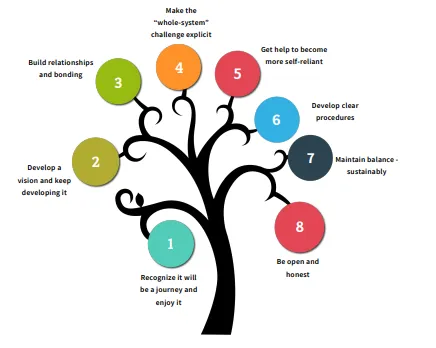Constructing a sustainable community transcends being merely eco-friendly; it entails weaving a rich mosaic of social, financial, and environmental elements. Inspired by Robert Gilman's seminal piece on eco-village formation, we've augmented the model with four additional vital steps that are close to our hearts.
Here is your in-depth roadmap to fostering a community that is not merely sustainable but profoundly transformative.
- Embrace the Journey – Relish It! Understanding that community-building is a marathon, not a sprint, is paramount. It is essential to savor the process, leaning on perseverance, affection, and tenacity as faithful allies during this voyage.
- Craft a Vision – And Continually Refine It A collective vision serves as the community's cornerstone, continually aligning with the changing objectives of the community members, fostering unity and purpose.
- Rurban Living : Harnessing the Best of Both Realms By merging the positives of both rural and urban lifestyles, the "Rurban" strategy seeks to elevate neighboring communities through skill development programs, fostering a mutually beneficial partnership that nurtures everyone involved.
- Cultivate Bonds and Relationships The heartbeat of any community lies in robust interpersonal connections. Undertaking activities such as sharing meals, narrating stories, and embarking on group journeys can cement these fundamental ties.
- Samavridhi : Universal Prosperity "Samavridhi," a term rooted in Sanskrit, embodies the principle of "well-being for all." This ethos expands the notion of prosperity to embrace the welfare of all living entities, fostering a habitat where every creature can flourish.
- Addressing the Whole-System Challenge Transparently With a solid vision and relationships established, the subsequent phase involves pinpointing and tackling the challenges that lie ahead, facilitating a harmonious and fruitful community dynamic.
- Navigating the Seven Facets of Sustainability This stage emphasizes the integral Seven Facets of Sustainability: Water, Soil, Air, Food, Earth, Energy, and Community. Recognizing the intertwined nature of these elements is key, as a shift in one inevitably influences the others.
- Seek Assistance – Cultivating Self-Reliance Communities must acknowledge that they cannot have all the answers initially. Pursuing external guidance while nurturing in-house competencies creates a balanced, informed, and autonomous community.
- Unreal Estate : Prioritizing Conservation Over Consumption This approach transforms the conventional ethos of real estate development. The emphasis here is on resource conservation and optimization, a strategy that is both environmentally responsible and economically prudent.
- Establishing Unambiguous Protocols Formulating clear protocols for decision-making, conflict resolution, and fiscal administration is essential to avert potential future conflicts, fostering a cohesive community environment.
- Achieving Sustainable Equilibrium : Maintaining a healthy equilibrium is vital, necessitating a careful calibration between individual and collective interests, present and future requirements, and diverse perspectives within the community.
- Fostering Transparency and Candor : Open dialogue, especially concerning delicate matters like community power structures, can avert numerous challenges. Being forthright and transparent about these dynamics ensures a harmonious community fabric.
Developing a sustainable community is a fluid, ever-evolving endeavor, necessitating unwavering dedication to the holistic well-being of all its members.
By embedding these 12 crucial guideposts into your eco-village or community project, you are setting a strong foundation for a community that not only flourishes sustainably but serves as a lighthouse of comprehensive well-being.
For further insights, delve into Robert Gilman's foundational article here.
At Organo, these principles are firmly established. We welcome your thoughts on what else we could incorporate or streamline.
 Contact us
Contact us
